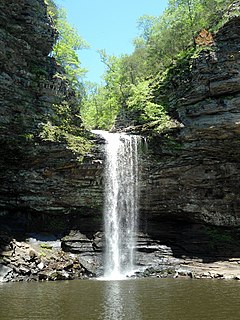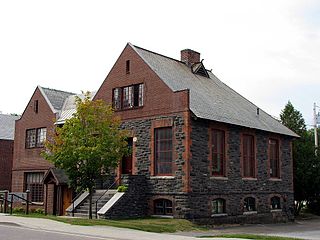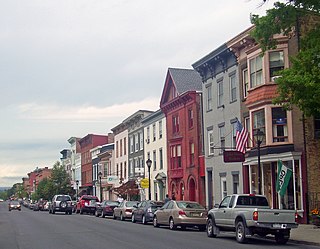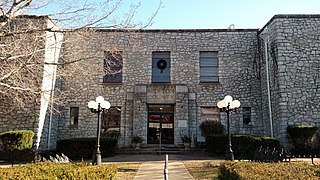
Saranac Lake is a village in the state of New York, United States. As of the 2010 census, the population was 5,406. The village is named after Upper, Middle and Lower Saranac lakes, which are nearby.

Petit Jean State Park is a 3,471-acre (1,405 ha) park in Conway County, Arkansas managed by the Arkansas Department of Parks and Tourism. It is located atop Petit Jean Mountain adjacent to the Arkansas River in the area between the Ouachita Mountains and Ozark Plateaus.

Glenn Dale Hospital was a tuberculosis sanatorium and isolation hospital in Glenn Dale, Maryland, in the United States. It is a large facility, consisting of 23 buildings on 216 acres (87 ha), that was built in 1934 and closed in 1981 due to asbestos.

The University of Illinois Experimental Dairy Farm Historic District, also known as South Farm, is a designated historic district in the U.S. state of Illinois. It is located on the campus of the University of Illinois in Urbana, Illinois. The district consists of eight contributing structures and several non-contributing structures. The district was designated in 1994 when it was added to the National Register of Historic Places as part of the Multiple Property Submission concerning Round Barns in Illinois. Three of the district's buildings are early 20th century round barns constructed between 1908 and 1912. The district covers a total area of 6 acres (2 ha).

Between 1873 and 1945, Saranac Lake, New York became a world-renowned center for the treatment of tuberculosis, using a treatment that involved exposing patients to as much fresh air as possible under conditions of complete bed-rest. In the process, a specific building type, the "Cure Cottage", developed, built by residents seeking to capitalize on the town's fame, by physicians, and often by the patients themselves. Many of these structures are extant, and their historic value has been recognized by listing on The National Register of Historic Places.

The Adirondack Cottage Sanitarium was a tuberculosis sanatorium established in Saranac Lake, New York in 1885 by Dr. Edward Livingston Trudeau. After Trudeau's death in 1915, the institution's name was changed to the Trudeau Sanatorium, following changes in conventional usage. It was listed under the latter name on the National Register of Historic Places in 1995.

Historic Saranac Lake is a non-profit, membership organization dedicated to the preservation of the history and architectural heritage of the Saranac Lake area of New York State in the Adirondacks.

The Hudson Historic District includes most of downtown Hudson, New York, United States, once called "one of the richest dictionaries of architectural history in New York State". It is a 139-acre (56 ha) area stretching from the city's waterfront on the east bank of the Hudson River to almost its eastern boundary, with a core area of 45 blocks. It has 756 contributing properties, most of which date from the city's founding in 1785 to the mid-1930s. In 1985 it was listed on the National Register of Historic Places.

There are 70 properties listed on the National Register of Historic Places in Albany, New York, United States. Six are additionally designated as National Historic Landmarks (NHLs), the most of any city in the state after New York City. Another 14 are historic districts, for which 20 of the listings are also contributing properties. Two properties, both buildings, that had been listed in the past but have since been demolished have been delisted; one building that is also no longer extant remains listed.

The University of Arkansas Campus Historic District is a historic district that was listed on the National Register of Historic Places on September 23, 2009. The district covers the historic core of the University of Arkansas campus, including 25 buildings.

The Birch Lodge, also known as the Birch Lodge Hospital and Summer Resort Sanitarium or the Trout Lake Sanitarium, is a resort facility located on the northern shore of Trout Lake, off County Route H-40, .6 miles (0.97 km) west of MI-123, in Trout Lake Township, Michigan. It was listed on the National Register of Historic Places in 1996 and designated a Michigan State Historic Site in 1987.

Mount McGregor is a mountain in Saratoga County, New York in the towns of Wilton, Moreau, and Corinth. It is one of the principal peaks of the Palmertown Range.
The Palmertown range is the most easterly of the five great mountain-chains which traverse the great wilderness. The Palmertown range begins on Lake Champlain, near Ticonderoga, and running down on both sides of Lake George, crosses the Hudson above Glen's Falls, and running through the town of Wilton, ends in the high ground of North Broadway, in Saratoga Springs.
The town of Colorado Springs, Colorado played an important role in the history of tuberculosis in the era before antituberculosis drugs and vaccines. Tuberculosis management before this era was difficult and often of limited effect. In the 19th century, a movement for tuberculosis treatment in hospital-like facilities called sanatoriums became prominent, especially in Europe and North America. Thus people sought tuberculosis treatment in Colorado Springs because of its dry climate and fresh mountain air. Some people stayed in boarding houses, while others sought the hospital-like facilities of sanatoriums. In the 1880s and 1890s, it is estimated that one-third of the people living in Colorado Springs had tuberculosis. The number of sanatoriums and hospitals increased into the twentieth century. During World War II, medicines were developed that successfully treated tuberculosis and by the late 1940s specialized tuberculosis treatment facilities were no longer needed.

Ottari Sanitarium, also known as the Coburn Apartments, is a historic building complex located at 491 Kimberly Avenue in Asheville, Buncombe County, North Carolina. The original section was built in 1912, and now forms the east end of the building. It is a three-story, stuccoed brick building with a hipped roof. It was enlarged in 1923, with the addition of a three-story, 14 bay brick addition, connected to the original building by a two-story section. The building was converted to apartments in 1937.

The Jasper Commercial Historic District encompasses the historic commercial center of Jasper, Arkansas. It includes the Newton County Courthouse, a 1930s Works Progress Administration building, and buildings that line the courthouse square, as well as some of the streets radiating from it. Built between the 1880s and 1940s, the district includes a high quality collection of commercial buildings constructed out of local stone. Most are one or two stories in height, and are vernacular to the period of their construction. Five of the district's 26 buildings were built by Gould Jones, a prominent local blacksmith and mason.

The Newton County Courthouse is located at Courthouse Square in the center of Jasper, the county seat of Newton County, Arkansas. It is a two-story masonry structure, constructed out of concrete and limestone, with restrained Art Deco styling. The building has an H shape, with a center section joining flanking projecting wings. The entrance is at the center, with "Newton County" inscribed in a panel above it, with stylized Art Deco elements. It was built in 1939 with funding from the Works Progress Administration. The building was listed on the National Register of Historic Places in 1994.

The former Newton County Jail is located at the junction of Spring and Elm Streets in Jasper, Arkansas. Built of local stone c. 1903–04, it served as a local lockup until 2009, when a new jail was opened. It is a two-story structure, located just off the courthouse square northwest of the county courthouse. Its main facade has a center entrance flanked by barred windows, and a larger two-leaf casement window, also barred, set in a segmented-arch opening, at the center of the second floor.

The First Avenue East Historic District is a nationally recognized historic district located in Newton, Iowa, United States. It was listed on the National Register of Historic Places in 2020. At the time it was studied for the City of Newton it contained 30 resources, which included 20 contributing buildings and 10 non-contributing buildings. The district is mainly a residential area made up of single-family houses and their outbuildings. It is immediately adjacent to the Newton Downtown Historic District to the west. Many of the homes in the district were built by locally prominent businessmen, especially those involved with the washing machine industry, as well as bankers, and merchants; many of which contributed to the development of the City of Newton. There are many examples of high-style architecture popular when the houses were built in the late-19th and early-20th centuries. The most popular style in the district, however, is the two-story American Foursquare. There are also bungalows. In addition to houses, there are several commercial buildings in the district, two of which, Jasper County Farm Bureau (1952) and Yes Way Gas Station (1968) are contributing properties. The August H. Bergman House is individually listed on the National Register of Historic Places and four others have been deemed to be individually eligible.

The First Avenue West Historic District is a nationally recognized historic district located in Newton, Iowa, United States. It was listed on the National Register of Historic Places in 2020. At the time it was studied for the City of Newton it contained 33 resources, which included 25 contributing buildings and eight non-contributing buildings. The district is mainly a residential area made up of single-family houses and their outbuildings. It is immediately adjacent to the Newton Downtown Historic District to the east. Many of the homes in the district were built by locally prominent businessmen, especially those involved with the washing machine industry, as well as bankers, and merchants; many of which contributed to the development of the City of Newton. There are many examples of high-style architecture popular when the houses were built in the late-19th and early-20th centuries. The most popular style in the district, however, is the two-story American Foursquare. There are also bungalows. In addition to houses, there are two commercial buildings, an apartment building, and New City Hall all of which are non-contributing properties due to their age. Two of the houses have been deemed to be individually eligible for the National Register of Historic Places.


















